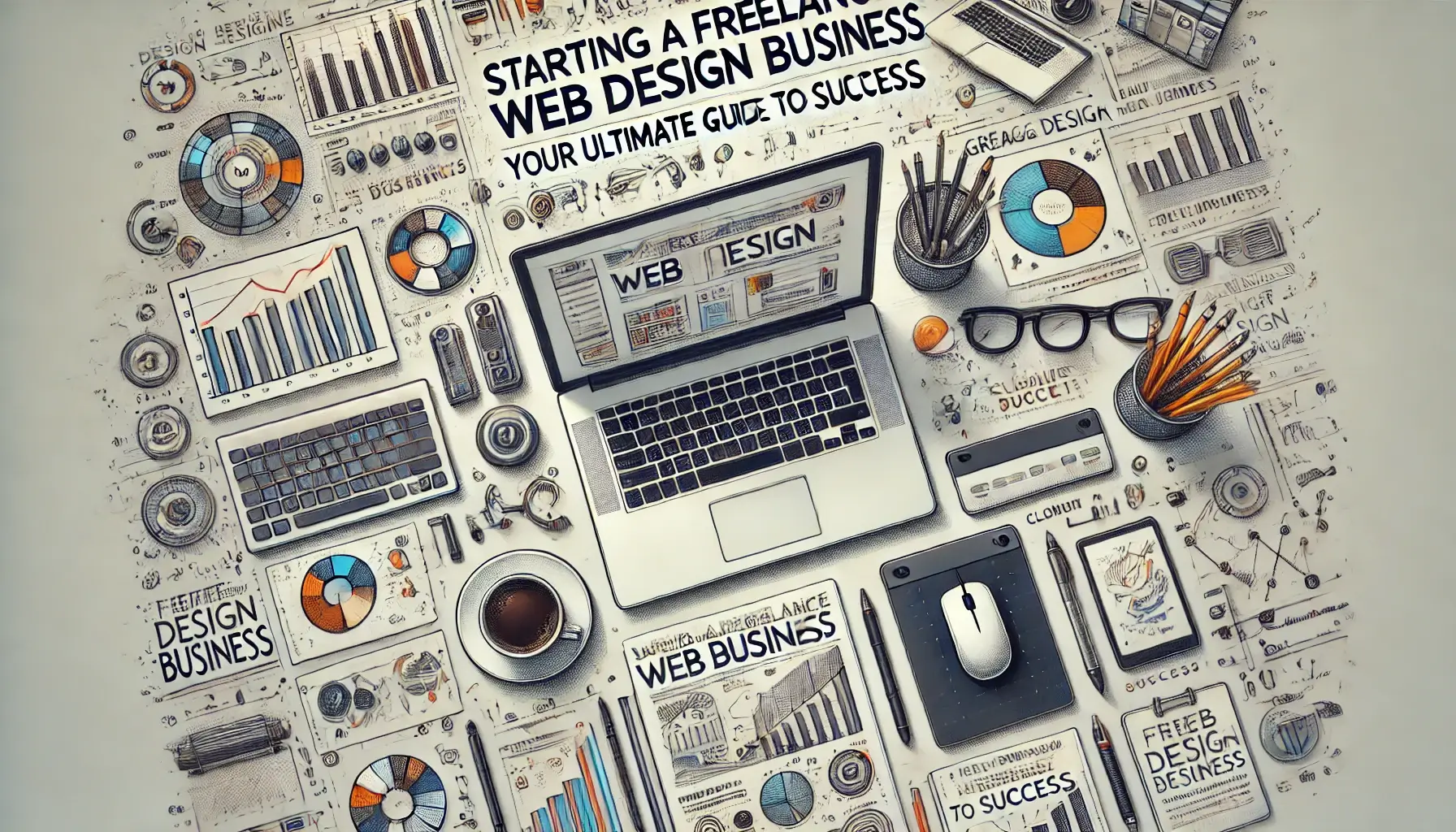As technology continues to dominate the business landscape, the demand for skilled web designers has soared. More than ever, businesses need websites that are not only visually appealing but also functional, user-friendly, and optimized for search engines. This has created countless opportunities for freelancers to establish thriving careers in web design. If you’ve been thinking about starting a freelance web design business, this comprehensive guide will walk you through every step of the process.
1. Introduction to Freelance Web Design
Starting a freelance web design business is an exciting journey that allows you to combine creativity with technology. A freelance web designer is responsible for creating websites that meet the aesthetic and functional needs of a client. As a freelancer, you have the flexibility to work on your own terms, choose your clients, and decide which projects to take on.
However, as rewarding as it can be, the road to becoming a successful freelance web designer requires planning, commitment, and continuous learning. In this guide, we’ll provide a roadmap to help you establish a strong foundation for your freelance web design business and achieve long-term success.
2. Why Start a Freelance Web Design Business?
There are several reasons why many professionals choose to start a freelance web design career. Some of the top benefits include:
- Independence: Freelancing allows you to work independently without being tied to a single employer. You’re in charge of your work schedule, workload, and clients.
- Flexibility: Freelance web designers often work from home or from anywhere in the world, making it ideal for those who want flexibility in their lifestyle.
- Unlimited Earning Potential: The more you grow your business, the higher your income potential. You can charge premium rates, especially as you build a reputation for delivering high-quality work.
- Creative Freedom: As a freelance web designer, you can explore your creative ideas and solutions without the constraints of traditional work environments.
3. Understanding the Freelance Web Design Market
Before diving into freelancing, it’s important to understand the freelance web design market. The demand for web designers is vast, as almost every business needs an online presence. Startups, small businesses, e-commerce platforms, and established companies all require custom websites that align with their branding and goals.
Moreover, industries such as healthcare, education, entertainment, and retail increasingly rely on well-designed websites to attract and retain customers. As a freelance web designer or freelance web and graphic designer, this opens up numerous opportunities for you to niche down and cater to specific markets.
4. Key Skills Every Freelance Web Designer Must Have
To thrive as a freelance web designer, there are several skills you need to develop:
- Technical Skills: Proficiency in HTML, CSS, JavaScript, and responsive design is essential. Knowledge of CMS platforms such as WordPress is also highly beneficial.
- Graphic Design Skills: Basic knowledge of graphic design tools like Adobe Photoshop, Illustrator, and Sketch will enable you to create visually appealing web pages.
- SEO Skills: A well-designed website is useless if it doesn’t rank well in search engines. Understanding SEO best practices will help you design websites that attract organic traffic.
- Communication Skills: Effective communication with clients is crucial in freelancing. You’ll need to understand your client’s vision, provide regular updates, and manage expectations.
- Project Management: Freelancers must juggle multiple projects and deadlines, so strong project management skills are essential.
5. Setting Up Your Freelance Web Design Business
Now that you have an understanding of the market and necessary skills, it’s time to set up your freelance business.
5.1 Choosing Your Niche
Specializing in a niche helps you stand out in a crowded market. You might focus on freelance web designer work for e-commerce, non-profits, or even freelance WordPress web designer services. Selecting a niche allows you to become an expert in a specific area, which can help attract clients seeking specialized services.
5.2 Tools and Software You’ll Need
To get started, invest in the essential tools of the trade, including:
- Design Software: Adobe Creative Suite, Figma, or Sketch.
- Development Tools: Visual Studio Code, Sublime Text, or Dreamweaver.
- Project Management Tools: Trello, Asana, or Monday.com to manage your workload.
- Client Communication Tools: Zoom, Slack, or Google Meet for client meetings.
6. Building a Professional Portfolio
Your portfolio is your most powerful marketing tool. It showcases your best work and provides potential clients with insight into your skills and expertise. When building your portfolio:
- Showcase a Variety of Projects: Include examples of freelance web designer work for different industries, demonstrating your versatility.
- Highlight Your Unique Selling Proposition (USP): Whether you’re a freelance web designer and developer or focus exclusively on design, make your strengths clear.
- Keep it Updated: Regularly add new projects to your portfolio to show growth and keep potential clients interested.
7. Pricing Your Services: How to Set Competitive Rates
Setting your rates is one of the most challenging aspects of freelancing. Here are key considerations:
- Hourly vs. Project-Based Pricing: Decide whether you will charge by the hour or per project. Freelance web designers often charge hourly for smaller tasks and project-based rates for larger, more complex jobs.
- Research Industry Rates: Look at the average rates for freelance web designer work from home in your region or niche to ensure your pricing is competitive but sustainable.
- Adjust for Experience: As you gain experience and a larger client base, you can gradually increase your rates.
8. Marketing Your Freelance Web Design Business
Once your business is set up, it’s time to find clients. Marketing is essential for any freelance web designer developer, and there are several ways to get your name out there.
8.1 Building an Online Presence
Start by building a website that showcases your portfolio and services. SEO optimize your website using keywords like freelance web designer developer and freelance WordPress web designer to attract organic traffic. Additionally, maintain active profiles on platforms like LinkedIn and Behance to increase your visibility.
8.2 Networking and Getting Clients
Networking is one of the most effective ways to grow your business. Join freelance communities, attend local events, and leverage social media platforms to connect with potential clients. Websites like Upwork, Fiverr, and Toptal are also great places to start looking for freelance web designer work.
9. Freelance Web Designer Work: What to Expect
As a freelance web designer, your work can vary widely depending on the client and project. Some common tasks include:
- Consulting with Clients: Understanding client needs, goals, and target audience.
- Creating Design Mockups: Developing wireframes and prototypes.
- Building and Testing Websites: Writing code, testing for functionality, and ensuring responsive design.
- Revisions and Final Launch: Making revisions based on client feedback and preparing the website for launch.
10. Working as a Freelance Web and Graphic Designer
If you’re skilled in both web and graphic design, you can offer additional services such as creating logos, branding materials, or marketing graphics. This expands your client base and makes you more versatile as a freelancer.
11. The Role of a Freelance Web Designer and Developer
A freelance web designer and developer handles both the design and coding of websites. Combining these skills gives you an edge in the market, as clients often prefer to hire someone who can manage the entire process from concept to completion.
12. The Benefits of Being a Freelance Web Designer Developer
Working as a freelance web designer developer offers several advantages:
- Full Control Over Projects: You have complete ownership of both the design and technical aspects of a website.
- Higher Earning Potential: Clients are willing to pay more for a professional who can handle all aspects of web development.
- Streamlined Workflow: Managing both design and development allows for better communication and efficiency.
13. How to Hire a Freelance Web Designer
From the client’s perspective, knowing how to hire a freelance web designer is crucial for a successful project. Here are a few tips:
- Evaluate Portfolios: Review portfolios to find someone with experience in your industry.
- Ask for Referrals: Referrals from trusted sources can lead you to the right freelance web designer.
- Test Communication: Clear communication is key. Make sure the designer understands your vision and can articulate how they’ll meet your goals.
14. Freelance Web Designer Work from Home: The Ultimate Dream Job
One of the greatest perks of freelancing is the ability to work from home. As a freelance web designer, you can set your own hours and work from the comfort of your home office, coffee shops, or even while traveling. However, this lifestyle requires discipline and time management to stay productive.
15. Freelance WordPress Web Designer: Specializing in WordPress Development
As a freelance WordPress web designer, you can specialize in creating custom WordPress themes, plugins, and websites. WordPress powers over 40% of the web, making it one of the most popular platforms for businesses. Specializing in WordPress allows you to tap into a high-demand market.
16. Managing Freelance Web Design Projects: Best Practices
Effective project management is essential in freelancing. To manage your projects:
- Set Clear Expectations: Agree on timelines, deliverables, and communication protocols upfront.
- Use Project Management Tools: Tools like Asana or Trello help you track progress and stay organized.
- Regular Communication: Keep clients updated on the progress of their project to maintain trust and transparency.
17. Common Challenges Freelance Web Designers Face
Freelancing comes with its own set of challenges, including:
- Inconsistent Income: Freelancers often face periods of feast or famine, where work is either plentiful or scarce.
- Client Management: Some clients may have unrealistic expectations or demand last-minute changes.
- Work-Life Balance: Without a clear separation between work and personal life, it’s easy to overwork.
18. How to Scale Your Freelance Web Design Business
Once you’ve established yourself, you can scale your business by:
- Expanding Your Service Offerings: Offering complementary services like SEO or digital marketing can help you attract more clients.
- Hiring Assistants or Collaborating: As your workload increases, consider hiring other freelancers to assist you.
- Raising Your Rates: As your portfolio and experience grow, you can justify charging higher rates.
19. FAQs: Everything You Need to Know About Freelance Web Design
Q. How do I find freelance web design clients?
A. You can find clients through online platforms like Upwork, Fiverr, and LinkedIn, as well as by networking and word-of-mouth referrals.
Q. How much do freelance web designers charge?
A. Rates vary depending on experience, location, and the complexity of the project. Freelancers can charge anywhere from $20 to $150 per hour or offer fixed project rates.
Q. Is a degree required to become a freelance web designer?
A. No, a degree is not required. However, having a strong portfolio and the necessary technical skills is essential.
Q. Can I work as both a web designer and a developer?
A. Yes, many freelancers offer both design and development services. This can make you more attractive to clients.
Q. How do I specialize in WordPress as a freelance web designer?
A. You can specialize in WordPress by mastering the platform, learning how to create custom themes and plugins, and keeping up with the latest WordPress trends.
Q. What are the biggest challenges in freelance web design?
A. Common challenges include finding consistent work, managing clients, and balancing multiple projects at once.
Conclusion
Starting a freelance web design business is a rewarding career path that offers creativity, flexibility, and the potential for high earnings. With the right skills, a strong portfolio, and a solid marketing strategy, you can attract clients, build a thriving business, and enjoy the benefits of working on your own terms. Remember, success as a freelancer requires continuous learning and adaptation, so stay up-to-date with the latest web design trends and technologies to keep growing your business.


